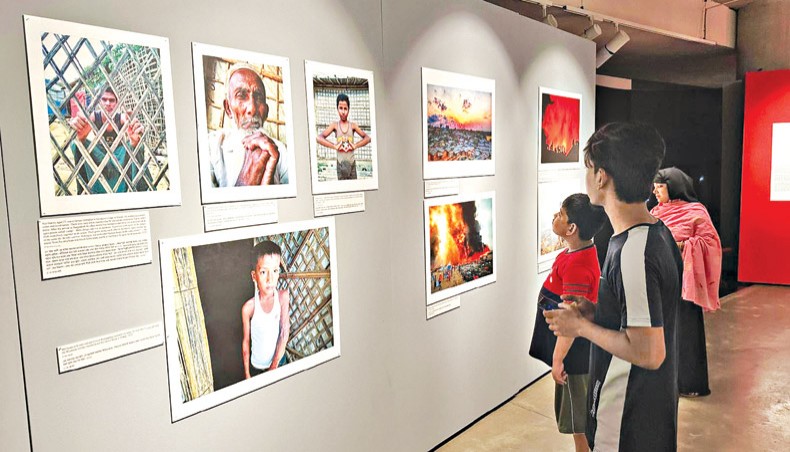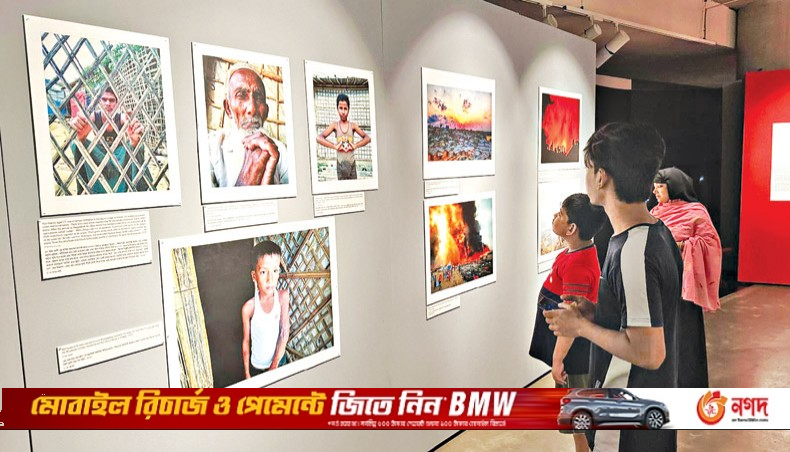[ad_1]

Visitors watch a photo exhibition titled ‘Zindigi Rohingyar Sukortu’ (Life through Rohingya Eyes) at the Liberation War Museum in Dhaka organised by the United Nations refugee agency on the occasion of World Refugee Day. — New Age photo
A number of Rohingya youths in Bangladeshi camps find photography a medium to protect their life, culture, tradition and struggle as well as reach out to global audiences.
Speaking to New Age over the phone, young photographers said that they wanted to mobilise opinion globally with their photographs and short videos for a sustainable repatriation to Myanmar from where they were forcibly displaced at different times, largely in 2017.

Sahat Zia Hero, the founder of Rohingyatographer Magazine, trained youths in Rohingya camps to help them to learn photography and often held workshops for those who showed their interest in photography.
‘Our main objective is to highlight our life, our community, lifestyle, our happiness, dream and hope and our challenges globally,’ he said, adding, ‘We seek similar attention from the world as they pay it to other refugees.’
‘We do not want to be a forgotten community. Sometimes, we feel the international communities are forgetting us,’ he added.
He hoped that their photography would help them to raise awareness and mobilise opinion internationally for their ‘sustainable’ repatriation.
Like him, Mohammed Zonaid, senior executive member of Ukhia-based Omar’s Film School, said that they had come to Bangladesh about six years ago, but their issue now had almost been forgotten in the public discourse and even in the international discussion.
‘Funds have been cut, and we may face a lot of problems in days to come,’ he said.
He also said that he tried to project the struggle of his community people, and what are the challenges the Rohingya people overcoming every day.
‘So, we want to highlight our stories…We want to tell our stories in our ways…We are getting a positive response so far,’ he said.
Shahida Win, a poet and a photographer, said she tried to document their culture thorough photography to transmit the photographs to those of their community people living abroad or for the next generation.
She believed that the international community would be informed about the culture through the photography.
On the occasion of World Refugee Day on June 20, the United Nations refugee agency organised a 20-day photo exhibition ‘Zindigi Rohingyar Sukortu’ (Life Through Rohingya Eyes) in Liberation War Museum in Dhaka with the photos of David Palazon, Shahida and Sahat, among others. It will continue until July 10.
After visiting the exhibition, Billal Hossain, a 27-year-old youth, said, ‘The exhibition gives a window into the way Rohingya people live.’
A woman was seen strolling at the temporary gallery of the museum with her two children and looking at the photos mostly about the Rohingya lifestyles, and their struggle in the camps in Cox’s Bazar due to the monsoon and the inclement weather.
A replica of Rohingya camp in Cox’s Bazar was also installed to portray their living condition.
The International Organisation for Migration and the Rohingya community recently have jointly launched the Rohingya Cultural Memory Centre in Cox’s Bazar, a curating interactive gallery, a digital archive, and web-based exhibition.
[ad_2]
